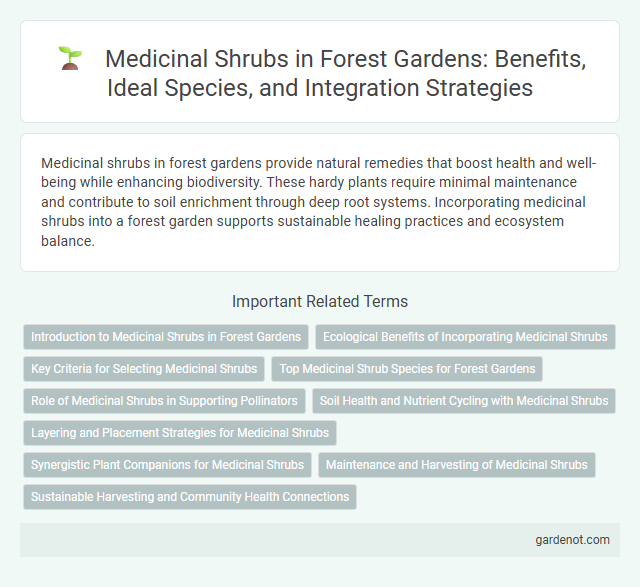Medicinal shrubs in forest gardens provide natural remedies that boost health and well-being while enhancing biodiversity. These hardy plants require minimal maintenance and contribute to soil enrichment through deep root systems. Incorporating medicinal shrubs into a forest garden supports sustainable healing practices and ecosystem balance.
Introduction to Medicinal Shrubs in Forest Gardens
Medicinal shrubs in forest gardens serve as vital components for natural health and biodiversity, offering a sustainable source of herbal remedies and therapeutic compounds. These shrubs, such as elderberry (Sambucus nigra), witch hazel (Hamamelis virginiana), and rosehip (Rosa canina), provide essential phytochemicals that support immune function, inflammation reduction, and wound healing. Cultivating medicinal shrubs within forest gardens enhances ecological resilience while promoting traditional medicine practices and self-sufficiency in herbal healthcare.
Ecological Benefits of Incorporating Medicinal Shrubs
Medicinal shrubs in forest gardens enhance biodiversity by providing habitat and food for pollinators and beneficial insects, which supports ecosystem stability. Their deep root systems improve soil structure and nutrient cycling, reducing erosion and promoting water retention. Incorporating these shrubs contributes to natural pest control and disease resistance, minimizing the need for chemical inputs and fostering a healthier environment.
Key Criteria for Selecting Medicinal Shrubs
Key criteria for selecting medicinal shrubs in a forest garden include adaptability to local climate, soil compatibility, and proven therapeutic properties. Selecting species with high phytochemical content, such as alkaloids, flavonoids, and essential oils, ensures effective medicinal benefits. Additionally, shrubs with low maintenance requirements and resistance to pests contribute to sustainable and productive forest garden ecosystems.
Top Medicinal Shrub Species for Forest Gardens
Top medicinal shrub species for forest gardens include elderberry (Sambucus nigra), renowned for its immune-boosting berries and flowers, and witch hazel (Hamamelis virginiana), valued for its astringent bark and leaves used in skin treatments. Other essential shrubs are lemon balm (Melissa officinalis), known for its calming effects and antiviral properties, and lavender (Lavandula angustifolia), prized for its antiseptic and anti-inflammatory benefits. These shrubs thrive in diverse forest garden layers, contributing both ecological balance and natural health remedies.
Role of Medicinal Shrubs in Supporting Pollinators
Medicinal shrubs such as lavender, echinacea, and rosemary provide essential nectar and pollen resources that attract and sustain diverse pollinator species, including bees, butterflies, and hummingbirds. These shrubs enhance forest garden biodiversity by supporting pollinator populations critical for the pollination of various plants, thereby promoting ecosystem stability and resilience. Their aromatic flowers not only aid in pollinator attraction but also contribute to natural pest control, reducing the need for chemical interventions.
Soil Health and Nutrient Cycling with Medicinal Shrubs
Medicinal shrubs in forest gardens play a crucial role in enhancing soil health by fixing nitrogen, improving soil structure, and promoting beneficial microbial activity. These shrubs contribute to nutrient cycling by efficiently absorbing and redistributing essential minerals, which supports the growth of surrounding plants and maintains ecosystem balance. Integrating medicinal shrubs such as Berberis or Witch Hazel enriches soil fertility and fosters sustainable, resilient garden systems.
Layering and Placement Strategies for Medicinal Shrubs
Layering medicinal shrubs in a forest garden enhances root development and ensures better nutrient absorption while promoting natural propagation. Strategic placement involves situating these shrubs in partial shade under taller canopy trees to mimic their native understory habitats, which supports optimal growth and medicinal compound production. Incorporating companion plants that improve soil health and repel pests further strengthens the vitality and resilience of medicinal shrubs within the garden ecosystem.
Synergistic Plant Companions for Medicinal Shrubs
Medicinal shrubs such as elderberry, witch hazel, and rosemary thrive when paired with synergistic plant companions like comfrey, yarrow, and chamomile, which enhance soil nutrients and deter pests. Comfrey's deep roots mine minerals benefiting shrubs, while yarrow attracts beneficial insects that improve pollination and pest control. Chamomile promotes essential oil production in medicinal shrubs, boosting their therapeutic potency and overall growth.
Maintenance and Harvesting of Medicinal Shrubs
Medicinal shrubs in forest gardens require regular pruning to maintain healthy growth and enhance the concentration of active compounds. Harvesting is best done in the morning when essential oils and medicinal properties are at their peak, typically during the flowering or fruiting stages. Proper drying and storage of harvested parts preserve bioactive constituents, ensuring maximum therapeutic efficacy for future use.
Sustainable Harvesting and Community Health Connections
Medicinal shrubs in forest gardens, such as elderberry and neem, offer sustainable harvesting opportunities by regenerating naturally without disrupting ecosystem balance. These plants contribute to community health by providing accessible remedies for common ailments, promoting preventive care and reducing dependency on pharmaceuticals. Integrating sustainable harvesting practices ensures long-term availability and preserves biodiversity, supporting both ecological and social resilience.
Medicinal shrub Infographic

 gardenot.com
gardenot.com